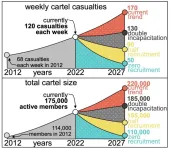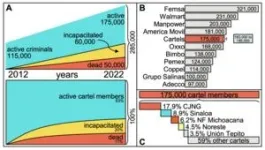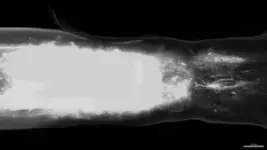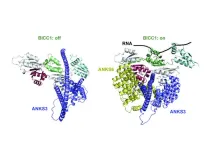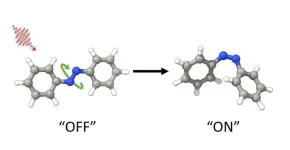(Press-News.org) Not through courts and not through prisons. The only way to reduce violence in Mexico is to cut off recruitment. Increasing incapacitation instead leads to both more homicides and cartel members, researcher Rafael Prieto-Curiel from the Complexity Science Hub and colleagues show in a study in Science.
In 2021, approximately 34,000 people died from intentional homicides in Mexico – the equivalent of nearly 27 victims per 100,000 population. This ranks Mexico among the least peaceful countries worldwide.
FIFTH LARGEST EMPLOYER
In order to be able to address this violence in the most targeted way possible, researchers now studied the cartels’ evolution by using data on murders, missing persons, and incarcerations in Mexico between 2012 and 2022. Therefore, they combined data from the National Institute of Geography and Statistics in Mexico (INEGI) on homicides, the national registry of missing persons (RNPDNO), and data from the Mexican prison census.
Their results show that Mexican cartels currently have between 160,000 and 185,000 members. This makes them the fifth largest employer in the country – with far-reaching effects on the population. And despite the state's efforts to limit the cartels' power by, for example, imprisoning nearly 6,000 cartel members annually, the cartels have increased their membership by 60,000 since 2012.
RECRUITING 350 PEOPLE PER WEEK
At the same time, they themselves lose many members to killings. “The career path of cartels is very short and violent. In 10 years, 17% of the people recruited by cartels will be dead, and 20% will be incapacitated in some prison,” explains Rafael Prieto-Curiel from the Complexity Science Hub. At least 350 people need to be recruited per week to avoid collapse due to total losses, the researcher says.
MASSIVELY INCREASING VIOLENCE
Still, violence has not decreased. On the contrary, between 2012 and 2021, cartel-related deaths increased by 77%. “If Mexico continues this path, it will experience 40% more deaths by 2027 than it does today, and the cartels will have 26% more members,” Prieto-Curiel says. Even if it were possible to prosecute twice as many cartel members and have twice as many people in prison, there would still be 8% more deaths in 2027.
CUTTING OFF RECRUITMENT
In comparison, halving the cartel's ability to recruit would reduce weekly casualties by 25% and the cartel's size by 11% until 2027. "Mathematically, therefore, a preventive strategy is significantly more successful than a traditional reactive strategy," Prieto-Curiel emphasizes. However, the cartels are so large that even if recruitment were to drop to zero, it would take three years to return to the already high levels of violence seen in 2012. That's why swift and comprehensive action is needed.
FIRST SCIENTIFIC ATTEMPT
Despite the Mexican cartels' economic, social, and political importance, essential information about their size and the impact of various policies designed to limit their power has been lacking. “To the best of our knowledge, this work provides the first scientific attempt to mathematically quantify the size of cartels in Mexico and compare policy strategies to reduce violence in the country. We, therefore, hope to make an important contribution to a more peaceful future of Mexico,” Prieto-Curiel says.
________________
ABOUT THE COMPLEXITY SCIENCE HUB
The mission of the Complexity Science Hub (CSH) is to host, educate, and inspire complex systems scientists dedicated to making sense of Big Data to boost science and society. Scientists at the Complexity Science Hub develop methods for the scientific, quantitative, and predictive understanding of complex systems.
The CSH is a joint initiative of AIT Austrian Institute of Technology, Central European University CEU, Danube University Krems, Graz University of Technology, Medical University of Vienna, TU Wien, VetMedUni Vienna, Vienna University of Economics and Business, and Austrian Economic Chambers (WKO). https://www.csh.ac.at
END
Immunotherapy, which uses the body’s own immune system to fight cancer, is an effective treatment option, yet many patients do not respond to it. Thus, cancer researchers are seeking new ways to optimize immunotherapy so that it is more effective for more people. Now, Salk Institute scientists have found that manipulating an early step in energy production in mitochondria—the cell’s powerhouses—reduces melanoma tumor growth and enhances the immune response in mice.
The study, published in Science on September 21, ...
A pair of independent studies, using recent James Webb Space Telescope (JWST) observations of carbon dioxide (CO2) ice on Jupiter’s moon Europa, indicate the CO2 originates from a source within the icy body’s subsurface ocean. The findings from both research groups provide new insights into the poorly known composition of Europa’s internal ocean. Beneath a crust of solid water ice, Jupiter’s moon Europa is thought to have a subsurface ocean of salty liquid water. Because of this, Europa is a prime target in the search for life elsewhere in the Solar System. Assessing this deep ...
A groundbreaking study, published today in Science, has provided new insights into the extensive impact of metal mining contamination on rivers and floodplains across the world, with an estimated 23 million people believed to be affected by potentially dangerous concentrations of toxic waste.
Led by Professors Mark Macklin and Chris Thomas, Directors of the Lincoln Centre for Water and Planetary Health at the University of Lincoln, UK – working with Dr Amogh Mudbhatkal from the University’s Department of Geography – the study offers a comprehensive understanding of the environmental and health challenges associated with metal mining activities.
Using ...
When the spinal cords of mice and humans are partially damaged, the initial paralysis is followed by the extensive, spontaneous recovery of motor function. However, after a complete spinal cord injury, this natural repair of the spinal cord doesn’t occur and there is no recovery. Meaningful recovery after severe injuries requires strategies that promote the regeneration of nerve fibers, but the requisite conditions for these strategies to successfully restore motor function have remained elusive.
“Five years ago, we demonstrated that nerve fibers can be regenerated across anatomically complete spinal cord ...
In order to keep track of their environment, cells use cilia, antenna-like structures that can sense a variety of stimuli, including the flow of fluids outside the cell. Genetic defects that cause cilia to malfunction and lose their sensory abilities can result in disorders known as “ciliopathies”, including polycystic kidney diseases; but they can also disrupt the correct asymmetric positioning of internal organs during embryonic development – what is known as “organ laterality”.
An example of such asymmetry is the heart, which is typically ...
New discovery allows scientists to change the shape of azobenzene molecules using visible light, which is more practical and safe than previously used ultraviolet light. Azobenzenes are incredibly versatile and have many potential uses, such as in making tiny machines and improving technology as well as making light controllable drugs. This molecule can switch between two different forms by light. However, the two forms are in equilibrium, which means that a mixture present that prevents optimal use for applications. Being able to control them with visible light and enrich only one form opens up new possibilities for these applications, making them more efficient ...
In a new study in mice, a team of researchers from UCLA, the Swiss Federal Institute of Technology, and Harvard University have uncovered a crucial component for restoring functional activity after spinal cord injury. The neuroscientists have shown that re-growing specific neurons back to their natural target regions led to recovery, while random regrowth was not effective.
In a 2018 study published in Nature, the team identified a treatment approach that triggers axons — the tiny fibers that link nerve cells and enable them to communicate — to regrow after spinal cord injury ...
Imagine if humans could ‘talk’ to plants and warn them of approaching pest attacks or extreme weather.
A team of plant scientists at the Sainsbury Laboratory Cambridge University (SLCU) would like to turn this science fiction into reality using light-based messaging to ‘talk’ to plants.
Early lab experiments with tobacco (Nicotiana benthamiana) have demonstrated that they can activate the plant's natural defence mechanism (immune response) using light as a stimulus (messenger).
Light serves as a universal means of daily human communication, for example the signalling at traffic lights, pedestrian ...
Three independent state-of-the-art datasets reveal that the West Side has more nitrogen dioxide (NO2) pollution than the rest of the city
Depending on the month, residents in this area experience 16 to 32% higher NO2 concentrations on average
By identifying hotspots, residents and policymakers can be confident about where to prioritize immediate interventions
EVANSTON, Ill. — The western edge of Chicago — including the North and South Lawndale, East Garfield Park, Archer Heights and Brighton Park neighborhoods — experiences up to 32% higher concentrations of nitrogen dioxide (NO2) air pollution compared to the rest of the city, ...
ROCKVILLE, MD – The Biophysical Society is proud to announce its 2024 Society Fellows. This award honors the Society’s distinguished members who have demonstrated excellence in science and contributed to the expansion of the field of biophysics. The Fellows will be honored at the Biophysical Society’s 68th Annual Meeting, being held in Philadelphia, Pennsylvania from February 10-14, 2024. The 2024 Fellows are:
Rommie E. Amaro, University of California, San Diego, USA, is named a Biophysical Society Fellow for her work on developing methods to enable the simulation of biological molecules in situ and ...
